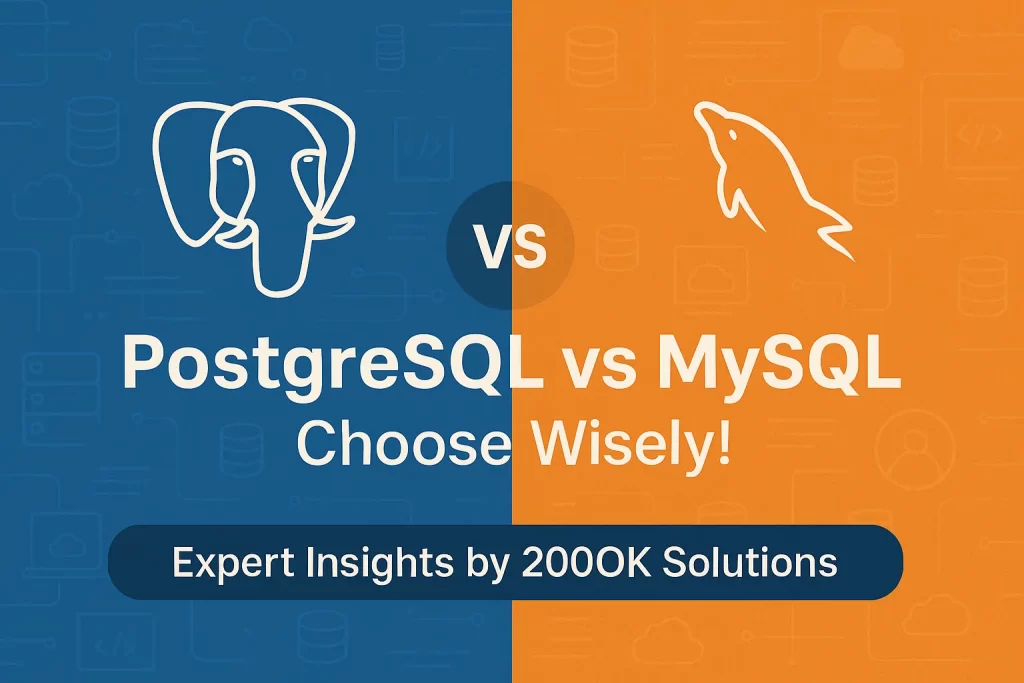
What’s the distinction between MySQL and PostgreSQL?
MySQL is a relational database management system (RDBMS) that stores data in tables with rows and columns. It is a widely used system that drives numerous online applications, dynamic websites, and embedded systems. PostgreSQL, an object-relational database management system, has more functionality than MySQL. It provides greater flexibility in data formats, scalability, parallelism, and data integrity.
What similarities exist between PostgreSQL and MySQL?
Both MySQL and PostgreSQL are relational database management systems. They hold data in tables connected by similar column values. Here’s an example.
- A company’s customer data is stored in a database called Customers, which has columns called customer_id, customer_name, and customer_address.
- The company also records product information in a database called Products, which has columns labeled product_id, product_name, and product_price.
- The organization uses a table called Customer_Orders with columns customer_id and product_id to keep track of the products each customer orders.
Here are some more similarities between PostgreSQL and MySQL:
- Both use SQL to read and update data.
- They are open source and supported by a robust developer community.
- Both include built-in data backup, replication, and access control capabilities.
Key differences between PostgreSQL and MySQL
While PostgreSQL and MySQL are theoretically similar, there are significant differences to consider before implementing either.
ACID Compliance
Atomicity, consistency, isolation, and durability (ACID) are database qualities that ensure a database’s validity even after unanticipated mistakes. For example, if you update a large number of rows but the system breaks halfway through, no rows should be changed.
MySQL provides ACID compliance only when used with the InnoDB and NDB Cluster storage engines or software modules. PostgreSQL is fully ACID compliant across all settings.
Control of concurrency
A sophisticated database feature called multiversion concurrency control (MVCC) makes redundant copies of records so that the same data can be safely read and updated concurrently. Multiple users can read and edit the same data at once with MVCC without sacrificing data integrity.
In MySQL, MVCC differs depending on the storage engine. For instance, using the InnoDB storage engine fully supports MVCC. The MyISAM storage engine does not support MVCC. MVCC is supported by PostgreSQL in every configuration.
Indexes
Indexes help databases retrieve data more quickly. By setting up the database management system to classify and store frequently accessed data differently from other data, you can index that data.
MySQL is capable of storing hierarchically indexed data using B-tree and R-tree indexing. Trees, expression, partial, and hash indexes are among the different types of PostgreSQL indexes. As you grow, you have more options to fine-tune your database performance needs.
Types of data
The database MySQL is exclusively relational. In contrast, PostgreSQL is an object-relational database. This implies that data can be stored in PostgreSQL as objects with properties. Many computer languages, including Java and.NET, use objects as a common data type. Paradigms such as inheritance and parent-child relationships are supported by objects.
For database developers, PostgreSQL is easier to use. XML and arrays are among the numerous data types that PostgreSQL supports.
Perspectives
The database system generates a view, which is a subset of data, by extracting pertinent information from several tables.
Views are supported by MySQL, however PostgreSQL provides more sophisticated view choices. To generate materialized views, for instance, you can precompute some values beforehand, such as the sum of all orders during a specified time period. For complex queries, materialized views enhance database performance.
Procedures that are stored
Stored procedures are code statements or structured query language (SQL) queries that you can develop and save ahead of time. Database management operations are made more efficient by the ability to reuse the same code repeatedly.
Although stored procedures are supported by both MySQL and PostgreSQL, PostgreSQL enables you to invoke stored procedures that are written in languages other than SQL.
Triggers
A trigger is a stored process that initiates automatically in the database management system in response to a connected event.
Only AFTER and BEFORE triggers are compatible with SQL INSERT, UPDATE, and DELETE statements in a MySQL database. This implies that the process will execute automatically either before or after the user makes changes to the data. On the other hand, PostgreSQL allows you to use functions to execute complex SQL statements by supporting the INSTEAD OF trigger.
How to select between PostgreSQL and MySQL?
For the majority of use cases, both relational databases are appropriate. Before deciding on a course of action, you might take into account the following aspects.
Scope of application
Enterprise-level applications with complicated queries and frequent write operations are better suited for PostgreSQL.
If you wish to experiment, develop internal applications with fewer users, or develop an information storage engine with more reads and sporadic data updates, you can begin a MySQL project.
Experience with database development
MySQL offers a lower learning curve and is better suited for novices. Building a new database project from the ground up takes less time. MySQL can be easily set up as a stand-alone product or combined with other web development tools, such as the LAMP stack.
For beginners, however, PostgreSQL can be far more difficult. Usually, it calls for sophisticated infrastructure configuration and troubleshooting skills.
Performance standards
A preferable option is PostgreSQL if your application has to update its data often. MySQL is recommended, but, if you need to read data often.
Write performance.
Write locks are used by MySQL to accomplish true concurrency. For instance, another user might have to wait until the action is complete before making changes to the table if one user is altering it.
Nevertheless, PostgreSQL comes with built-in support for multiversion concurrency control (MVCC) that does not rely on read-write locks. In this manner, PostgreSQL databases function better when write operations are frequent and concurrent.
Read performance
For each user connected to the database, PostgreSQL generates a new system process with a substantial memory allocation (about 10 MB). Scaling for additional users necessitates memory-intensive resources.
MySQL, however, use a single process for numerous users. For applications that primarily read and show data to consumers, MySQL performs better than PostgreSQL.
Summary of differences: PostgreSQL vs MySQL
| Category | MySQL | PostgreSQL |
| Database technology | MySQL is a purely relational database management system | PostgreSQL is an object relational database management system |
| Features | MySQL has limited support of database features like views, triggers, and procedures | PostgreSQL supports most advanced database features like materialized views, INSTEAD OF triggers, and stored procedures in multiple languages. |
| Data types | MySQL supports numeric, character, date and time, spatial, and JSON data types. | PostgreSQL supports all MySQL data types along with geometric, enumerated, network address, arrays, ranges, XML, hstore, and composite. |
| ACID Compliance | MySQL is ACID compliant only with InnoDB and NDB Cluster storage engines. | PostgreSQL is always ACID compliant. |
| Indexes | MySQL has B-tree and R-tree index support. | PostgreSQL supports multiple index types like expression indexes, partial indexes, and hash indexes along with trees. |
| Performance | MySQL has improved performance for high-frequency read operations. | PostgreSQL has improved performance for high-frequency write operations. |
| Beginner support | MySQL is easier to get started with. It has a wider tool set for non-technical users. | PostgreSQL is more complex to get started with. It has a limited tool set for non-technical users. |

